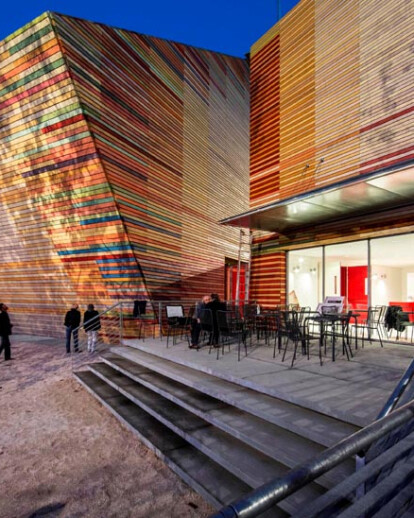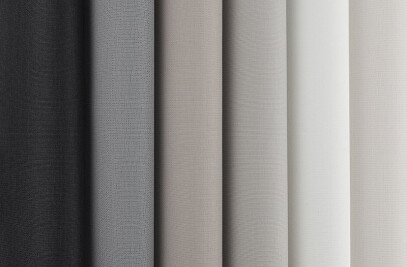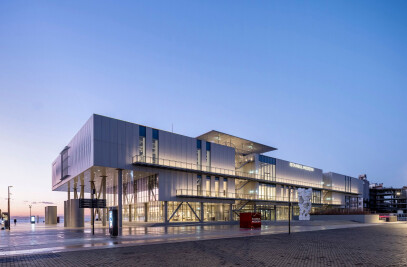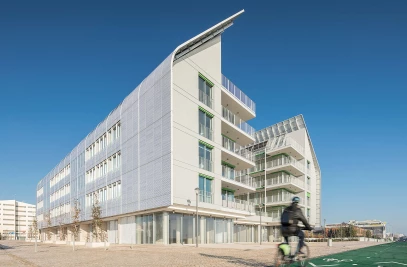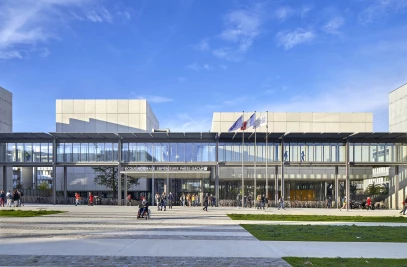Three wooden cubes
The Auditorium is formed of three wooden cubes that look as though they have somewhat haphazardly tumbled down and come to rest leaning against one another. The central, biggest cube, corresponding to the auditorium itself, seems to be tilting forward, as though about to topple over in an allusion to its instability. There is actually a specific reason for the slant: one of the two lower sides is sloped at the same angle as the stepped seating inside. The cubes may look abstract, but they conceal the presence of a real building. They are ‘non-forms’, or, rather, pure forms, that contrast with the 16th-century fort's taut, compact mass as inconspicuously as possible.
All three cubes are made entirely of wood, a material that makes no pretension of being anything but ephemeral but is actually eternal. The choice is dictated by the building's acoustic function, which is to sound like a musical instrument, but also by the context: the timber structures are actually highly earthquake resistant, and the wood's materiality ‘naturally’ contrasts with the castle's stone. What's more, wood is a renewable and therefore ecologically sustainable material: that is why 90 trees were planted near the Auditorium; eventually they will be able replenish to the timber used to build the cube.
The Auditorium can be thought of as a huge Stradivarius laid out in the park. The meticulous, intelligent building technique recalls the craftsmanship of master lute-makers and of building well. It is pleasant to think that larch from Val di Fiemme, in the Trentino, where the most highly-valued wood used by Cremona's 17th-century master lute-makers, Stradivarius being the most famous, traditionally came from, was used to build it. The building technology, and the use of cutting-edge earthquake-proof construction techniques in L’Aquila, is an example of building well that can also be used for the old town's reconstruction.
The facades' architectonic slope
The cubes' outer sides will be clad in larch tiles around 25 centimetres wide and four centimetres thick. The tiles are protected with special treatments aiming to guarantee correct aging due to homogenous oxidation processes. The 16 sides of the cubes that can be seen — two corresponding to the bases supporting the two service buildings — are not all equal but vary depending on various, alternating architectonic criteria that give the structure a light, lively, and vibrant look.
Various colours also provide visual interest.The sides feature a series of ‘accidents' that add variety to their wooden surfaces' homogeneity and geometry. The ‘accidents' include the staircase spaces contained in glazed volumes superimposed on the wooden surfaces, the blood-red surfaces corresponding to the vertical or horizontal connecting spaces, the fire escape attached to the facades where necessary, and the air-conditioning ducts, which, in the back wall of the foyer, emerge from the façade, treated with a cement finish here. On some occasions, when special musical events take place, big screens can be temporarily hung on the facades, in particular that of the Auditorium and foyer, for the projection of films and images.
The auditorium and the service volumes
The building is broken up into three separate but interconnected volumes: the central volume, which contains the actual auditorium, and the two service volumes: the public service areas, which contain the foyer, located on the town side, and the performers' service areas, which contain the dressing rooms, located on the castle side.
The auditorium's volume is a cube with 18.5-meter sides. Considering that part of the cube is located below ground level, the rear corner is 18.5 meters high above the ground and the front corner 9.2 meters high. The foyer is an 11-meter cube whose above-ground height is 10.9 meters. The dressing rooms are contained in a nine-meter cube with an above-ground height of 8.5 meters.
The auditorium is reached through the foyer, which contains a refreshment area, cloakroom and ticket desk. The foyer's volume contains the public lavatories and spaces equipped for various uses on the first floor, the air-conditioning system's technical rooms on the second floor and the power plant with direct access from outside stairs on the underground floor.
The public takes an elevated walkway, rising around one meter above ground, to reach the auditorium from the foyer. It will be glazed on the north side and protected with opaque surfaces on the south side and roof.
The 238-seat auditorium has a stage that can hold around 40 musicians. Two stepped seating areas facing each other accommodate the audience; the larger has 190 seats in front of the orchestra, the smaller, 48 seats behind it: the seats' angle ensures the best possible listening and viewing conditions. The walls' raw wood surfaces are hung with a series of acoustic panels orientated towards the audience to reflect sound inside the auditorium. The panels, also made of wood but with a high-quality finish, ‘soar’ in space, in some cases superimposed on the vertical walls, but always remaining detached from them, in other cases floating in space, hanging from above. Two approximately two-meter-high acoustic walls flanking the stage reflect sound towards the orchestra, ensuring the best possible listening conditions. The musicians' dressing rooms are on the side opposite the foyer and give access to the autonomous, independent room. This access, which crosses an elevated walkway similar to the one in the foyer, being directly connected with the exterior, is for the musical instruments, including large pieces such as pianos, harps, percussion instruments, etc. A ‘green area’ where the artists will be able to rest and meet one another is planned on the dressing-room volume's ground floor; two small spaces intended for the house manager and control booth are also planned. The conductor's and lead artists' (soloists or singers) dressing rooms, equipped with bath and a small waiting area outside, are located on the first floor. The orchestra musicians' dressing room and lavatories are on the second floor. The dressing room is modular: it can be subdivided into variously-sized spaces for men and women depending on the number of each in the guest orchestras.
The service volumes' various floors are interconnected by lifts whose size allows various kinds of users to take them. Access for means for the transport of instruments, for the provision of catering services and for the facilities' maintenance cross the outdoor area in front of the auditorium.
The piazza in front of the concert hall
The three volumes face each other in a large outside area conceived of as a natural link between the building and park but also as an area structured to extend the auditorium's functions outdoors in summer. The space in front of the foyer is fitted out to extend the foyer bar's catering activities, creating a pole of attraction that will surely be a nice place for a break. The area facing the auditorium's volume can be fitted with seating to accommodate around 500 people who will be able to attend open-air performances or follow concert activities on a big screen in summer. The outdoor area is laid out along axes springing from the sides of the Auditorium's three volumes, which intersect, generating patterns of dimensions and geometry
